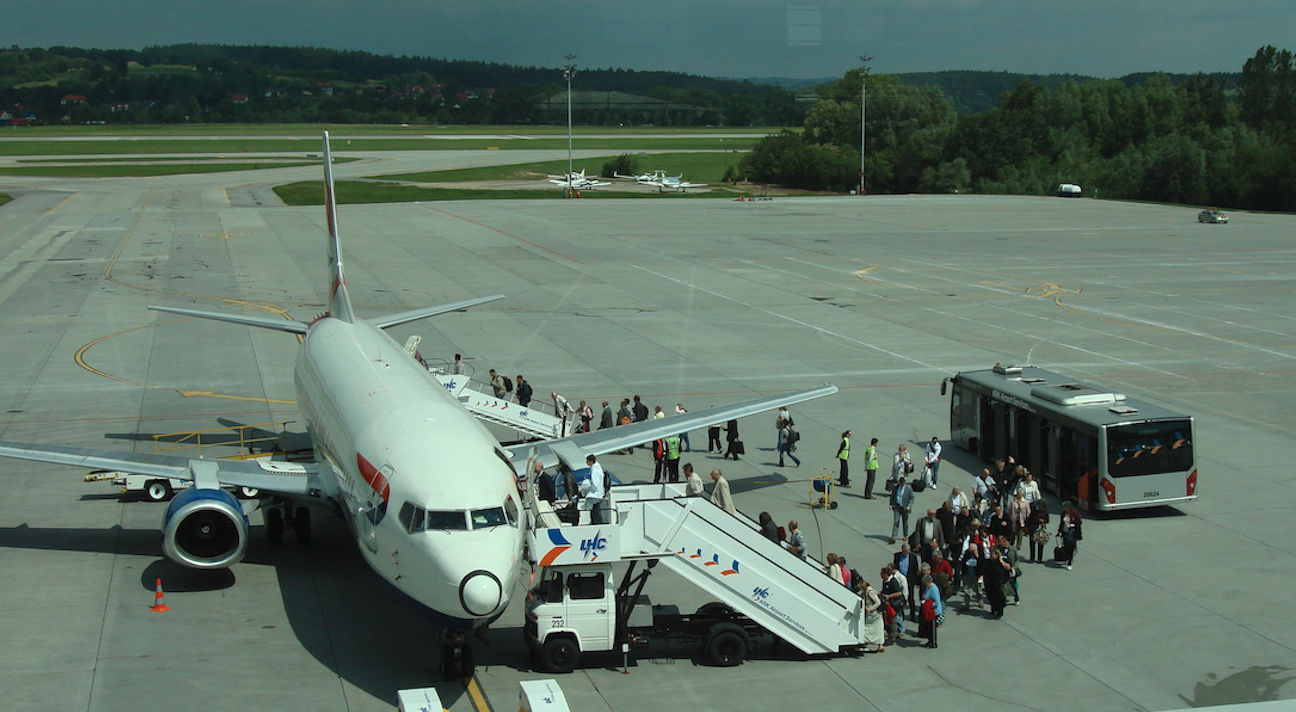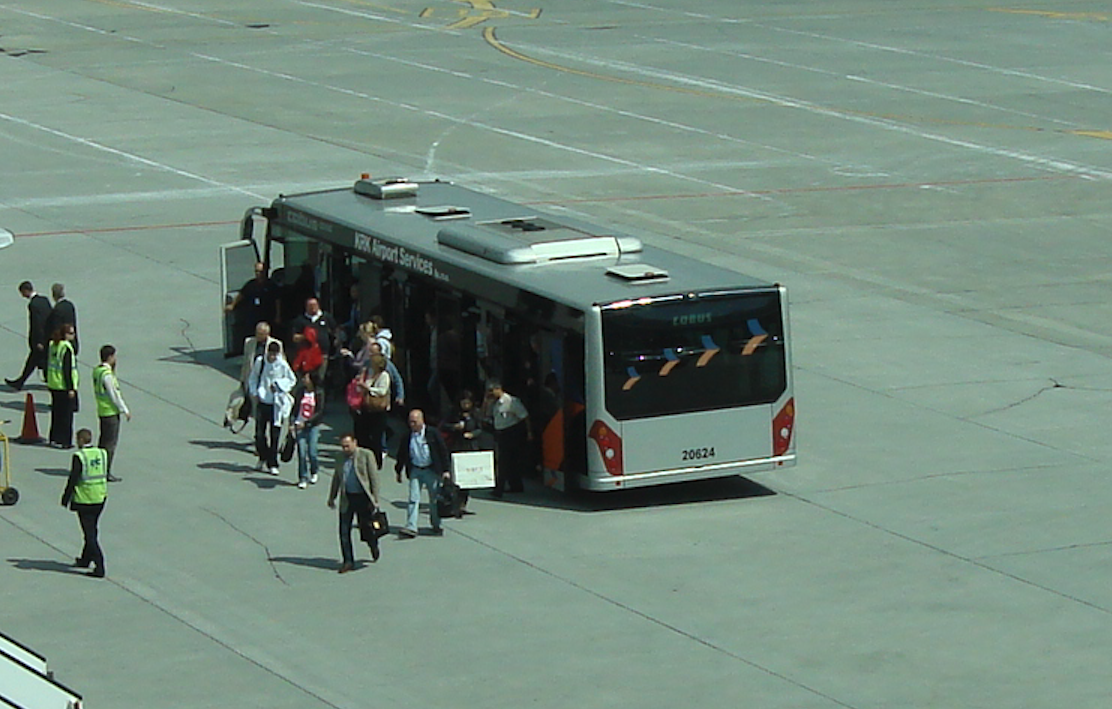Kraków 2017-10-09
Platform buses at the communication airport.


The name of the platform bus is little known in society. The problem is, when we talk about the airport bus, most people mean the bus that takes you to the airport (airport). We will therefore use the term platform bus. In the 60s, this name was common. In world literature, the term freight bus also appears.
For the average traveler, the journey from the terminal to the plane by bus is difficult to understand. Especially when the passenger covers a distance of less than 100 m with this bus. To explain it well, we must go back to the beginnings of the development of commercial passenger aviation.
In the 1940s, there was a dynamic development of passenger transport in the USA, and a few years later in Western Europe. At large airports, the number of platform (parking) places for aircraft, the so-called gates, or gates began to appear. Passengers who had already checked in, stood in front of the appropriate gate and waited for the moment when the airport flight attendant escorted them to the gangway of the plane on which they were to depart. When the plane was standing nearby there was no problem. But when the plane was over 500 meters, it was already a problem. On top of that, it might have been raining. After all, the passengers were usually wealthy people. Therefore, in great ports; New York, Los Angeles, Chicago, Atlanta began to use buses. The problem became even more apparent at the end of the 1950s, when turbojets were widely introduced and tickets became cheaper. More people could afford to travel by plane. So in front of the gate there were not 50 people, but 150 people. It was necessary to take care of their safety so that they would not get lost or create a danger for themselves and others. After all, not every day you walk on the platform of the airport, which for most of us is an unusual place, and above all, strange and unfriendly. The buses turned out to be a very good solution.
It is true that in large airports, the first so-called sleeves were built in the 60 years, which were initially called "an airbridge" - an air bridge. With these sleeves you can safely and comfortably board the plane, but for many reasons, the platform bus has remained and for at least 50 more years it will take us to the gangway of the plane at most airports in the world.
It is commonly believed that the sleeves used by passengers to board the plane are the perfect solution. Unfortunately, this is not the case. First of all, many airlines do not like sleeves, because boarding is done with only one entry. In exceptional cases, there are two sleeves, but they allow boarding of planes that have two pairs of doors in front of the wings. This single entry causes the bording to the deck to be temporarily extended. With buses, you can take passengers from the deck by two entrances, and at that time, new passengers are already prepared for the flight on this plane.
As shown by airport terminal designs that were developed in the 70s for Dublin, Montreal and Munich airports, the cost of building them with sleeves was 30-40% higher than the sleeveless terminal. Why? Because the length of the front wall of the terminal at the sleeves is much longer. For a gate with a sleeve where a Boeing B.747 stops, you need 70 meters of front. For the gate without a sleeve, only 16 m.
Although it seems like a one-off cost to build the deck, the sleeve should be more economical to operate. Unfortunately, this is not the case. In 1975, a study by the Airport de Paris company showed that the cost of building bridges and their 15-year operation is 15% higher than using buses. If the construction costs were not taken into account, the costs of using the platforms would be 10% lower than in the case of using buses. These results were confirmed by research conducted in the USA.
As a result, the new terminals were built in mixed configurations. This method was adopted in the new century by many airports in Poland: Okęcie, Balice, Strachowice, Rębiechowo and others.
Mobile Lounge - a mobile lounge.
In the 1960s, two directions for the construction of platform vehicles emerged. The first are typical platform buses. The second is mobile waiting rooms - "a mobile lounge". Currently, the exact translation is a mobile salon, and it should be a mobile (mobile) salon. Therefore, the name should not be associated with cell phones, which at that time did not exist and even people did not dream of.
The Mobile Lounge was an innovative design element of the design team led by architect Eero Saarinen, developed in 1962 for the Dulles Washington airport. The airport was expanded in the period 1958-1966. Designers were considering building an airbridge at the terminal or using running lounges. The second option was chosen.
The vehicles were developed and built by the Chrysler Corporation. Technically, the vehicle resembled a bus, the body of which was mounted on a raised chassis. The entrance to the vehicle was only from one end. As the vehicle approached the plane, the actuators lifted the door end of the vehicle. The other end of the vehicle body was on a hinge and remained at the same level. At this point, the floor of the vehicle was even sloping. When the tables were installed in the vehicle, everything that was placed on them fell down. Therefore, the lifting system was rebuilt, which carried the box from both sides. The entrance door was also mounted on the other side of the box. One input was used to connect to the plane and the other to the terminal. In fact, there were two entrances at each end of the vehicle. The vehicle was 54 ft (16.46 m) long and 16 ft (4.88 m) wide. It took 102 passengers on board. The vehicle weighs 76,000 kg and travels at a speed of 26 km / h. The operator's cabin was located both at one end and at the other end. Passenger vehicles were called "moon carts" due to their unusual appearance. Officially, the vehicle was called PTV - Passenger Transfer Vehicle, and popularly called Mobile Lounge.
After the first mobile showrooms of the PTV type - Passenger Transfer Vehicle were built and put into service, around 1980, another vehicle of this type was created. The main innovation was the use of two columns lifting the box and the operator's cabin at only one end of the vehicle. Characteristic for the vehicle are two superstructures on boxes in which the hydraulic lifting system is hidden, instead of the screw one. The entrances have also been modified and equipped with more convenient platforms. The vehicle was named Plane Mate. These vehicles are similar to the Mobile Lounge vehicles. Vehicles of this type were used to service passengers at Dulles and Dorval airports. Plane Mate vehicles were used in the shuttle flight program to transport astronauts after their flight.
Mobile lounges were used at airports in Washington, Montreal, New York, Paris (in the 80's). They were used the longest in Mexico City, until 2007. At Dulles Washington airport, these vehicles were used until 2010 to transport passengers between terminals and between the cable car station and the terminals. The expansion of the rail system put an end to these vehicles.
Mobile lounges have also been developed in other countries. Most of them had scissor and hydraulic vehicle body lifting systems.
In France, in 1978, Sovam began producing mobile lounges under the name Aero-Lounge. The vehicle was developed by Aeroport de Paris and the production was co-financed by the French government. The vehicle is 15 m long, 4.50 m wide and has four axles. The box is made of plastic reinforced with aluminum. The vehicle takes 150 passengers. Speed 45 km / h. A scissor lift. Working level (floors) from 2.00 m to 5.60 m in relation to the ground. The vehicle has a telescopic corridor (platform) with a maximum extension of 2.10 m, ended with a rubber collar.
The German (West Germany) also undertook the development of vehicles of this type. The program was implemented by the Trepel company, in cooperation with the French. The Trepel company was founded in 1946. It has specialized in scissor lifts for various sectors of the economy, including cargo loading devices for aviation. The company developed an elevating, mobile passenger lounge in the period 1978-1985. The vehicle is called a Lift-Lounge. The vehicle is 14.40 m long and 4.12 m wide. It takes 150 passengers. The design of the vehicle is almost identical to the French Aero-Lounge vehicle. Scissor lift, hydraulic. Speed 42 km / h. Vehicle weight 57,000 kg.
The company Mitsunishi in Japan also undertook the construction of mobile waiting rooms. Their vehicle also takes 150 passengers. It is structurally similar to French and Germanic vehicles. The floor rises 1.90 m to 5.45 m from the ground.
Other solutions.
In 1980, the Hungarian company Ikarus presented a concept vehicle that combined a mobile waiting room and a trunk for containers with travel suitcases. The vehicle is two-story. There are passengers on the upper deck who use the movable entrance / exit gangway located at the end of the vehicle. The lower deck is occupied by containers. The vehicle body is not raised. The vehicle has four axles. The Hungarian vehicle did not enter production.
In the second half of the 70s, NEOPLAN and Boeing developed a platform bus that combines the features of a mobile lounge and a typical platform bus. The bus called Jumbo Bus is double-decker. It is 15 m long, 4 m wide and 5 m high. It has four axes. It is powered by a diesel engine. It takes 118 passengers on board with a density of 4 people per square meter, or 177 people with a density of 6 people per square meter. There are 131 seats in the vehicle. Entry to the vehicle is possible thanks to three doors 1.50 m wide located in one or both side boards. Access to the upper deck is provided by wide internal stairs. Entry to the plane is provided by a door with a small gangway located on the upper deck. However, the vehicle did not attract much attention from airports and carriers, mainly due to its adaptation only to Boeing B.747 aircraft.
Written by Karol Placha Hetman
